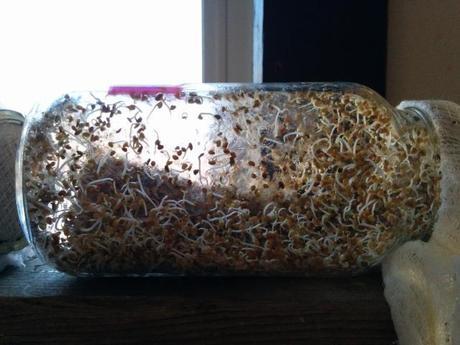After a relaxing weekend in Lions Head, I returned to Kitchener on Sunday to have a very productive week. Early in the week, my boyfriend and I headed out to buy seeds from a local farmer as well as plants for our windowsill. We are in the processing of sprouting beans, alfalfa, red clove and a few other seeds as well as growing wheat grass, basil, mint, chives and rosemary. I’m pretty impressed with how quickly and easily this stuff grows! In only about a week we’re going to hopefully have tons of sprouted seeds to stick in just about everything we eat. Very excited about our in-apartment gardening we have going. I went to the hospital on Thursday to check up on my recovery, remove some staples and get a swanky new hot pink cast. The cast is a huge improvement from my last one- so much lighter and more durable. I was also informed by my doctor that I can safely resume training. I was very happy to do some three limb climbing and workouts shortly after and am in the process of putting together a training program for the 4 weeks until (if all goes to plan) I get my cast off. While it was bitter-sweet, I also went to watch a regional bouldering competition at my local gym yesterday. Although I really wish I could have competed myself, I was very happy to see all of my climbing friends from Ontario. Wish me luck on my first day of work tomorrow and continue sending me positive healing vibes :).
More winter climbing in Kentucky!

Our windowsill plants!


Look at all of those alfalfa sprouts after only 2 days in!

After the leaps of the 20th century in medicine that lead to the prevention of virtually all transmissible diseases, the 21st century has been an age with a new and growing concern, paralleling our obesity epidemic. Since the 1950s, non-transmissible, chronic diseases have increased by as much as 400% in many regions, including diseases such as heart disease, type 2 diabetes, cancer, lung diseases and allergies. They are estimated by the World Health Organization to cause 36 million deaths around the world each year, accounting for 63% of mortality world-wide. In Canada, three out of five people over the age of twenty live with one of these diseases, and four out of five are at risk. Furthermore, chronic diseases cost over $90 billion annually for the combination of treatment and loss of productivity. In part one of this series, I discussed obesity and how properly addressing it can help pave the way to a healthier and more sustainable future. Building on obesity, this article will be about chronic diseases in the western world. Since obesity, inactivity and the overconsumption of unhealthy food are at the root of chronic diseases, addressing them with initiatives for early prevention could not only create a healthier future, but also one that is both more ecologically and economically-friendly. In future articles I will delve more into sustainability, the power of compassion and positive psychology and why we are currently unable to feed everyone. Am I missing anything that you think is important? Please share your opinions below!
Starting during the agricultural revolution and continuing through the industrial revolution, the foods we eat and lifestyles we lead have changed tremendously. Instead of transporting ourselves on-foot, we can sit in the comfort of a car. Instead of eating locally, a diet free of chemicals and hormones, our food is now brought to us from all over the world, with added sugar, salt and fat to create a tastier end-product. We spend our down-time plugged in and push our stress-limits at work. In an era with everything available at our fingertips, tucked away from the natural world, we’ve forgotten that we are in fact, still a component of the earth’s biodiversity. Our societal advances are not only destroying our environment, but also resulting in declining life-expectancies, quality of life and to generations more at risk to chronic disease. While inflammation is a normal and protective response from the immune system, unhealthy lifestyles can lead to excess inflammation that ultimately leads to tissue change and poorly functioning organs. These changes are the start points for a complex path of eventually irreversible damage that encapsulate disease. Since there are common risk factors for chronic disease, specifically the inflammation that is derived from our lifestyles, common solutions with an emphasis on prevention early in life are pivotal on our fight against chronic disease.
“Well”, you might say, “aren’t we just genetically inclined to certain diseases?” While genetics can have a small part in the development of disease, the bigger factor is our lifestyle and environment, the only explanation for the surge of chronic disease in the last century. In fact, only about 5% of the diseases of our industrial world are primarily attributed to genetics. Lifestyle and environmental influences can be demonstrated as early as in a new born in the form of allergy. A pregnant mother can have significant effects on her unborn baby’s susceptibility towards disease from the moment of conception to breast feeding patterns throughout the early life of her newborn. For example, the foods that the mother eats during pregnancy will influence the health of her child in the future. Diets high in fat or sugar, for example, have been demonstrated to result in a higher risk of obesity and diabetes for the unborn baby, ultimately enhancing the child’s risk of chronic disease. Breast feeding shapes the development of the baby’s immune system and reduces risks of obesity and disease with longer periods of breast-feeding up to around 7 months. As that child grows up, microbial exposure through non-sterile environments helps establish a healthy immunity and time spent playing outside provides ample vitamin D, a vitamin that is both commonly deficient and associated with inflammation and disease. Establishing healthy eating and lifestyle patterns (adequate sleep, exercise and healthy stress levels) early in life and maintaining those patterns through adulthood are pivotal in the prevention of chronic disease.
How do the foods we eat influence our risks for disease? Diets rich in refined foods, sugar, saturated fats, red-meat, excess calories and low in fiber and antioxidants will almost immediately result in systemic inflammation, and as a result, a lower immune function, blood sugar control, and internal antioxidant function, putting us at a heightened risk for disease. Our diets typically also have too high levels of omega-6 fats and too low levels of omega-3 fats (found in fish and many plant items). The skewed ratio of omega-6 to omega-3 fats, sometimes reaching ratios of 30:1 in western diets, are another major factor for inflammation and disease (healthier ratios would be closer to 1:1). On the flip side, plant-rich and mostly unrefined diets result in just the opposite. Despite the health promoting effects of fruits and vegetables, less than half of Canadian adults and about 70% of children don’t consume enough. As mentioned in part one of this series, these devastating statistics can be attributed to the high cost and lack of accessibility of fresh foods to many individuals. By providing initiatives for the consumption of locally derived foods, by choosing to walk or bike instead of hopping in the car or by spending more time in nature and less time plugged in, we can not only reduce our carbon footprint but also enhance our overall health and well-being.
What steps can we take for a healthier and more sustainable tomorrow? Eat more fruits and vegetables and consider a more plant-based diet! Purchasing your food from local farmers can be an excellent way to support their farms as well as reduce the environmental impact of transporting foods from abroad. More and more farmers markets are popping up, making it easier to eat locally sourced foods. These options are often times more affordable when purchased directly from the farmer, making them better for both your wallet and local economy. Gardening is another way to reduce your carbon footprint and enhance your accessibility to fresh food. It’s easy, fun and helps you reconnect with nature. In an apartment? Try growing indoors! Sprouting seeds as well as growing herbs and certain vegetables can be done right on your windowsill (stay tuned for an article about my current sprouting and herb growing endeavours). Plant-based diets are both more ecologically friendly, consuming 11 times less fossil fuel, 7 times less land and 100 times less fresh water, and provide some significant disease preventing benefits. For example, processed meat consumption was associated with a 42% increase in heart disease risk for each 50g/day increase in consumption, whereas plant-based diets are consistently associated with better health. A pooled analysis of several cohort studies involving about 76,000 individuals over a decade reported that vegetarians had a 24% reduction in death from heart disease when compared to regular meat eaters. Epidemiological data also suggests that cancer and diabetes rates are also lower in vegetarians. A plant-based and locally derived diet can be an excellent tool for building a more sustainable and healthier future. Spending less time in the car or indoors and more time outside, opting for biking or walking whenever possible, is another strategy to boost activity levels, reduce our risks for disease and lead eco-friendly lifestyles.
That was my thoughts, now it’s your turn. How do you think we can create a healthier and more sustainable future and reduce our toll of chronic disease?
Boeing H et. Al. (2012) Critical review: vegetables and fruit in the prevention of chronic diseases. Eur J Nutr 51:637–663.
McEvoy C, Temple N, Woodside J. (2012) Vegetarian diets, low-meat diets and health: a review. PubHealth Nutri., 15:12.
Prescott S. (2013) Early-life environmental determinants of allergic diseases and the wider pandemic of inflammatory noncommunicable diseases. J Allergy Clin Immunol 131:23-30.
Renz H et. Al. (2011) Gene-environment interaction in chronic disease: A European Science Foundation Forward Look. J Allergy Clin Immunol 128(6 Suppl):S27-49
Ruiz-Nunez B et. Al. (2013) Lifestyle and nutritional imbalances associated with Western diseases: causes and consequences of chronic systemic low-grade inflammation in an evolutionary context. J Nutr Biochem 24:1183–1201.
